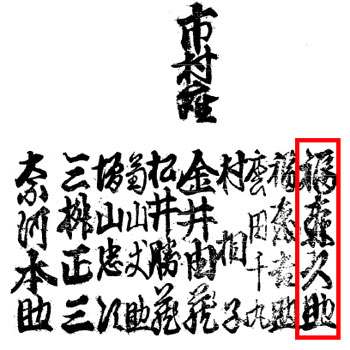| FUKUMORI KY█SUKE II |
|
Pen names:
Line number: NIDAIME (II) Existence: ??? ~ ??? Connection: Masters: Segawa Kikunoj˘ V, Matsumoto K˘shir˘ V, Nakamura Daikichi I, Ichikawa Danjűr˘ VII Disciple: Matsumoto K˘ji II Career: Before 1809: his first pen name was Tamazawa Kisuke. He became a playwhright disciple of Ichikawa Danjűr˘ VII and received the name of Narita Yasuke. 11th lunar month of 1809: he worked at the Ichimuraza for the tatesakusha Katsu Hy˘z˘ I on the kaomise drama "Misao no Hana Toba no Koizuka". 11th lunar month of 1813: because of his adultery with the daughter of a sushiya, he could not use anymore the Naritaya name. He became Koremori Yasuke and worked at the Moritaza on the kaomise drama "Gohiiki Tsunagi Uma". 1814 ~ 1820: he took the name of Sh˘ya Suke. Then, he worked for the actor Nakamura Daikichi I. He became masterless again and took the name Masumi K˘ji. Then he became disciple of Matsumoto K˘shir˘ V and received the name of Matsumoto K˘ji I. 11th lunar month of 1820: K˘ji worked for the tatesakusha Hon'ya S˘shichi at the Tamagawaza on the kaomise drama "Koe Kakete Hikeya Takatsuna". The only star of this kaomise was Band˘ Mitsugor˘ III and there was no tateonnagata in the casting. There was also the premiere of the dance "Fumi Uri", which was performed in the dance program "Hana Momiji Shin˘ K˘sh˘" (the main role was played by Band˘ Mitsugor˘ III). The lack of funding led to the departure of Band˘ Mitsugor˘ III, who went to ďsaka, and the stopping of performances at the Tamagawaza. 8th lunar month of 1823: K˘ji worked at the Moritaza on the drama "Chűshingura Netsugi no Ishizue". 1823 ~ 1828: around that time, K˘ji had some sentimal interest in Band˘ Mitsugor˘ III's wife Oden. He became a regular guest at Band˘ Mitsugor˘ III's home. But Oden finally eloped with Segawa Kikunoj˘ V and later became the wife of the Hamamuraya rising star. As a result of this new case of adultery, K˘ji had to leave Band˘ Mitsugor˘ III and he started to work directly for Segawa Kikunoj˘ V. 11th lunar month of 1828: K˘ji worked at the Nakamuraza, along with Tsuruya Nanboku IV, Segawa Jok˘ II and Tajima Konosuke I, on the kaomise drama "Motomishi Hana Otogi Heike"; K˘ji's yearly salary was 30 ry˘ [1]. 11th lunar month of 1829: K˘ji worked at the Nakamuraza on Tsuruya Nanboku IV's final drama "Kin no Zai Sarushima Dairi" [more details]. He wrote the lyrics of the Tokiwazu-based dance-drama "D˘j˘ji Koi ha Kusemono" which was staged within this drama. 11th lunar month of 1830: K˘ji worked with Segawa Jok˘ II at the Kawarasakiza on the kaomise drama "Ichiy˘ Raifuku Shibuya Tsuwamono". 3rd lunar month of 1831: premiere at the Nakamuraza of the five-role hengemono "Rokkasen Sugata no Irodori" which was written by K˘ji [more details]. 11th lunar month of 1831: K˘ji worked with Segawa Jok˘ II at the Kawarasakiza on the drama "Matsu o Chikara Tomoe no Fujinami", which celebrated the shűmei of Sawamura Tossh˘ I. 7th day of the 1st lunar month of 1832 [2]: Segawa Kikunoj˘ V died. 11th lunar month of 1833: he took the name of Fukumori Kyűsuke II at the Ichimuraza, working on the kaomise drama "Koi Yoriiru Tsui no Yumitori". 11th lunar month of 1835: Kyűsuke worked at the Ichimuraza on the drama "Kigoto no Hana Hitome Senbon". 11th lunar month of 1836: Kyűsuke worked at the Moritaza on the kaomise drama "Kioi Genji Mitsugi no Tamamono". 11th lunar month of 1837: Kyűsuke worked at the Ichimuraza on the kaomise drama "Onikirimaru Mimasu no Kakutsubo". No record afterwards. Comments: Fukumori Kyűsuke II was an Edo sakusha, who was active from the end of the 1800s to the second half of the 1830s. All his masters were Kabuki actors and he worked a lot for Tsuruya Nanboku IV or Segawa Jok˘ II. He will stay in Kabuki history as the playwright who wrote the lyrics of "Rokkasen Sugata no Irodori". [1] Tsuruya Nanboku IV, the best Edo playwright, was paid 175 ry˘. Matsumoto K˘shir˘ V, the zagashira at the Nakamuraza, was paid 600 ry˘. [2] The 7th day of the 1st lunar month of the 3rd year of the Tenp˘ era was the 8th of February 1832 in the western calendar.
The name of Fukumori Kyűsuke II in a 1834 Edo hy˘banki (the name within the red box); all the names were the sakusha working at the Ichimuraza The Matsumoto K˘ji line of playwrights The Fukumori Kyűsuke line of playwrights |
|
|
| Contact | Main | Top | Updates | Actors | Plays | Playwrights | Programs | Links | FAQ | Glossary | Chronology | Illustrations | Prints | Characters | Derivatives | Theaters | Coming soon | News |
